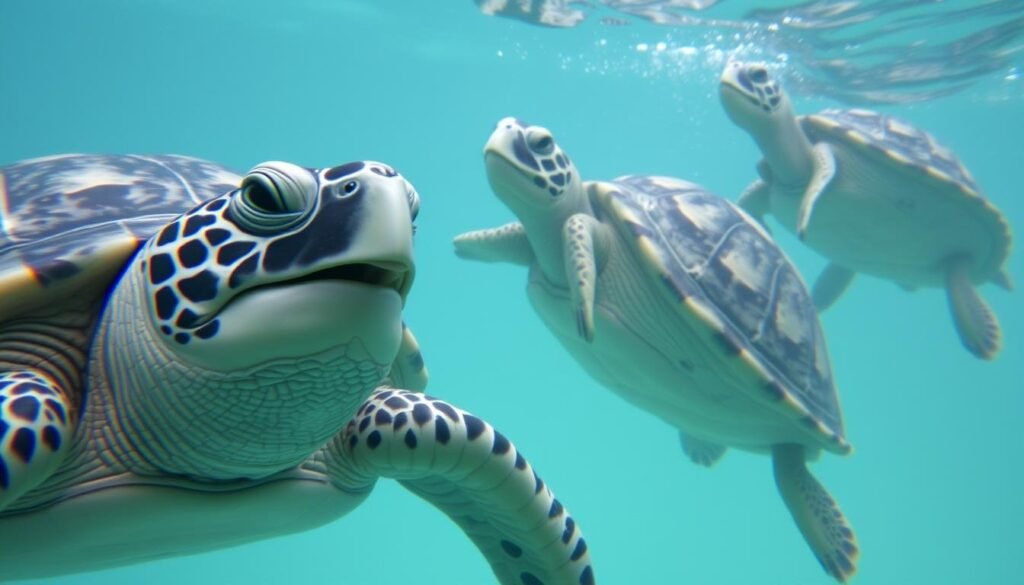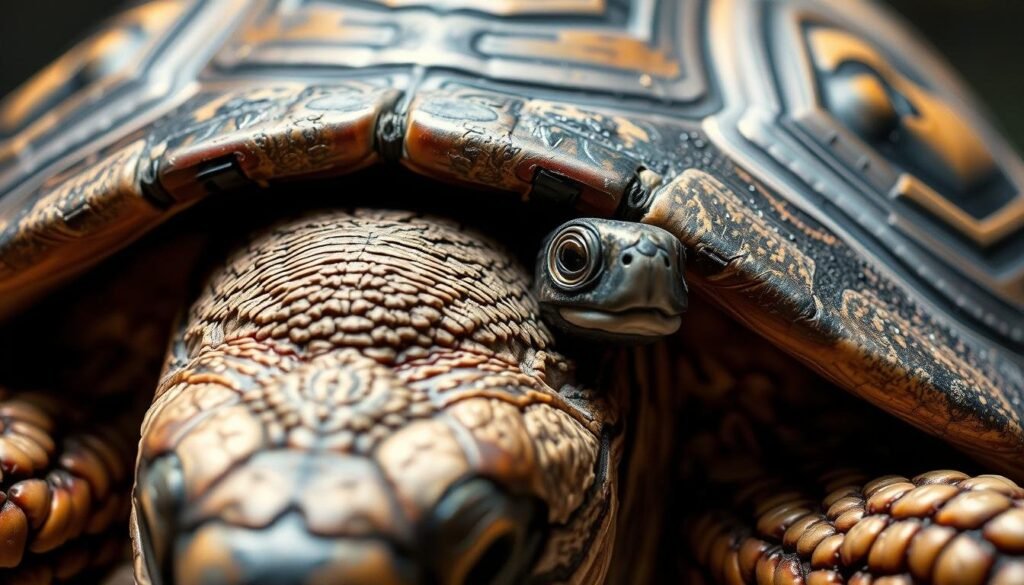Why Turtles Retract Heads Into Shells for Defense? Have you ever wondered how turtles keep safe from predators? They have a special way to protect themselves. They retract their heads into their shells.
This behavior is key to their survival. It gives them a safe place to hide from dangers. By pulling their heads back, turtles make it hard for predators to get to them.
This defense is very effective. It helps turtles survive in different places. As you learn more about turtles, you’ll see how amazing their head-retraction ability is.
Contents
- 1 The Unique Anatomy of Turtle Shells
- 2 Why Do Turtles Retract Heads Into Shells for Defense?
- 3 The Evolution of This Defensive Behavior
- 4 Different Retraction Methods Among Turtle Species
- 5 The Biomechanics of Head Retraction
- 6 Other Defense Mechanisms Used by Turtles
- 7 Limitations of Shell Protection
- 8 Understanding Turtle Defense Mechanisms
- 9 FAQ: Why Turtles Retract Heads Into Shells for Defense?
- 9.1 Why do turtles retract their heads into their shells?
- 9.2 What is the structure of a turtle shell?
- 9.3 How do turtles protect their limbs when retracting their heads?
- 9.4 What are the different methods of head retraction among turtle species?
- 9.5 What other defense mechanisms do turtles use besides retracting their heads?
- 9.6 Are there any limitations to the shell protection mechanism?
- 9.7 How do the biomechanics of head retraction work in turtles?
- 9.8 What are the selective pressures that shaped the evolution of head retraction in turtles?
The Unique Anatomy of Turtle Shells
The turtle shell is a complex structure. It has several components that work together for protection. It is divided into two main parts: the carapace and the plastron.
Carapace and Plastron Components
The carapace is the top part of the shell. The plastron is the bottom part. Both are covered in scutes, which are keratinized plates. The carapace and plastron are connected by a bridge, forming a protective shell around the turtle’s vital organs.
Material Properties of Turtle Shells
The turtle shell is strong and durable. The bony elements give it a rigid framework. The scutes add extra protection against abrasion and predators. This structure and material make the shell an effective defense.
See how the turtle’s shell helps it retract its head for defense. The carapace, plastron, and scutes together form a strong protective system.
Why Do Turtles Retract Heads Into Shells for Defense?
Turtles have a unique way to defend themselves by pulling their heads into their shells. This is a key survival tactic. It helps them avoid predators and harsh weather.
Protection from Predator Attacks
Turtles hide their heads to avoid being attacked. By doing this, they lower the chance of being bitten or clawed. Predator protection is a big part of their defense.
Creating an Impenetrable Fortress
When turtles pull their heads and limbs back, they make a strong defense. It’s hard for predators to get a hold or bite. The shell protects their weak spots.
Turtles’ heads and necks are easy targets for predators. By pulling them back, they lessen the risk of getting hurt. This shows how good their defense mechanisms are.
Limb Protection Strategies
Turtles also hide their limbs in their shells for more protection. This complete defense keeps all weak spots safe.
| Defense Mechanism | Description | Benefit |
|---|---|---|
| Head Retraction | Retracting the head into the shell | Protects against predator bites |
| Limb Retraction | Pulling limbs into the shell | Prevents limb injury |
| Shell Closure | Closing the shell completely | Creates an impenetrable fortress |
In summary, turtles pull their heads into their shells for defense. This, along with pulling in their limbs and closing their shells, offers strong protection. It keeps them safe from predators and harsh weather.
The Evolution of This Defensive Behavior
Learning about turtles’ head-retraction behavior shows how they survive. This defense has grown over millions of years. It was shaped by many pressures.
From Partial to Complete Retraction
The move from partial to full head retraction in turtles is a big evolutionary adaptation. At first, turtles could only partially pull their heads back. But, over time, they could do it fully. This gave them better protection.
| Evolutionary Stage | Head Retraction Ability | Predation Pressure |
|---|---|---|
| Early Turtles | Partial Retraction | High |
| Modern Turtles | Complete Retraction | Variable |
Selective Pressures That Shaped Retraction
Predation and environmental challenges drove turtles’ defensive evolution. Being able to fully pull their heads into their shells was a big plus. It helped them survive better, making this trait common in today’s turtles.
Studying these evolutionary adaptations tells us a lot about turtles’ past. It also shows their incredible ability to adapt and survive.
Different Retraction Methods Among Turtle Species
Turtles have different ways to pull their heads into their shells. This shows how adaptable they are to their surroundings and predators.
Horizontal Neck Folding Technique
Some turtles fold their necks sideways into their shells. This is common in side-necked turtles.
Other turtles pull their heads straight back into their shells. This is seen in cryptodire turtles, who can hide their heads fully for safety.
These different ways help turtles protect themselves from predators. It shows how their shells have evolved to be effective.
The Biomechanics of Head Retraction
The way turtles can pull their heads into their shells is quite interesting. It shows how their bodies have adapted over time. The neck muscles are key to this process.
The neck muscles are very important for this action. They help turtles pull their heads into their shells quickly. The longus colli and sternohyoid muscles work together to make this happen.
Neck Muscles and Their Functions
The longus colli muscle helps bend the neck, pulling the head towards the body. The sternohyoid muscle then pulls the head even further into the shell. Together, they make the head retraction smooth and efficient.
| Muscle | Function |
|---|---|
| Longus Colli | Flexes the neck, pulling the head towards the body |
| Sternohyoideus | Assists in retracting the head into the shell |
Learning about how turtles retract their heads shows their amazing adaptability. The neck muscles and their roles are a result of evolution. They help turtles protect themselves from predators.
Other Defense Mechanisms Used by Turtles
Turtles have many ways to protect themselves, not just by hiding in their shells. These extra methods help them stay safe.
Musk Glands and Secretions
Some turtles have musk glands. They release bad smells to scare off predators. This works well for predators that hunt by smell.
Freezing and Playing Dead
Certain turtles freeze or pretend to be dead when scared. This trick, called thanatosis, can confuse predators and stop them from attacking.
Aggressive Responses
Some turtles get very defensive when faced with danger. They use their strong jaws to fight back. This can scare off some predators.
| Defense Mechanism | Description | Effectiveness |
|---|---|---|
| Musk Glands | Release foul-smelling secretions | High against smell-based predators |
| Freezing/Playing Dead | Thanatosis to confuse predators | Variable, depends on predator |
| Aggressive Response | Using powerful jaws to defend | High against certain threats |

Limitations of Shell Protection
The turtle shell is a remarkable defense, but it’s not perfect. It keeps many predators away, but some threats can still get through.
Specialized Predator Adaptations
Some predators have special ways to beat the turtle shell. For instance, big crocodiles and certain birds can crush a turtle’s shell. These predators have strong jaws and teeth to reach the turtle’s soft parts.
- Crocodiles use their powerful jaws to crush turtle shells.
- Some birds, like eagles and vultures, can drop turtles from heights to break their shells.
Human Impact and Conservation Concerns
Humans are a big threat to turtles, causing conservation concerns. Things like habitat loss, pollution, and climate change hurt turtles. Also, turtles get caught in fishing gear or hunted for their meat and shells.
It’s important to protect turtles. You can help by supporting groups that protect turtle habitats and fight pollution. Knowing about the turtle shell’s limits and the dangers turtles face helps us see why we need to act.
Understanding Turtle Defense Mechanisms
You now know why turtles pull their heads into their shells for defense. The special turtle anatomy helps them do this. It lets turtles hide from predators.
When turtles pull their heads back, they show less to threats. This, along with other ways to defend, helps them live longer. The ability to hide their heads in their shells is a smart move for turtles.
Each turtle species has its own way of pulling its head back. Knowing these differences helps us see how they adapt and survive.
See Also: Why Do Kangaroos Box Each Other in Fights?
FAQ: Why Turtles Retract Heads Into Shells for Defense?
Why do turtles retract their heads into their shells?
Turtles pull their heads into their shells to stay safe from predators. This helps hide their weak spots.
What is the structure of a turtle shell?
A turtle shell has two parts: the carapace on top and the plastron on the bottom. Both are covered in scutes, which are hard plates made of keratin.
How do turtles protect their limbs when retracting their heads?
Turtles also pull their limbs into their shells when they hide their heads. This makes their shell even stronger against predators.
What are the different methods of head retraction among turtle species?
Turtles have different ways to hide their heads. Some fold their necks horizontally, while others go straight into their shells. This shows how adaptable turtles are.
What other defense mechanisms do turtles use besides retracting their heads?
Turtles also use their musk glands to scare off predators. They can freeze or pretend to be dead. Sometimes, they even fight back to protect themselves.
Are there any limitations to the shell protection mechanism?
Yes, some predators have found ways to get past turtle defenses. Humans also harm turtle populations, which is a big worry for conservation.
How do the biomechanics of head retraction work in turtles?
Turtles have special muscles that help them pull their heads into their shells. This shows how their bodies are made for defense, but also has its limits.
What are the selective pressures that shaped the evolution of head retraction in turtles?
The need to avoid predators and survive in tough environments drove turtles to develop head retraction. This helped them stay safe over time.

Zyair Larson, based in Denver, Colorado, has over 12 years of experience studying animal behavior. He has worked with the World Wildlife Fund (WWF) and National Geographic, researching wildlife and sharing insights on animal habits globally.

